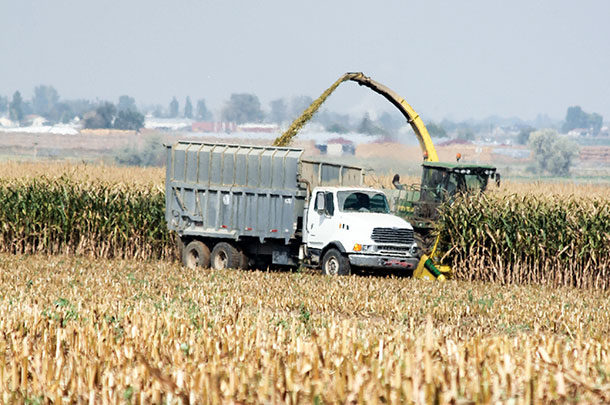It’s important to realize that having the correct moisture and maturity not only affects yield and quality coming off of the field but also impacts losses during fermentation. These differences can lead to lower-quality forage in ration balancing and animal performance.
To reach these ends, avoid harvesting corn silage outside of the ranges of optimal moisture and maturity.
The importance of correct moisture – when the crop is too wet or immature
We recommend harvesting corn silage around 36 percent dry matter to be in the optimal range. Harvesting corn silage before plants reach optimal moisture levels reduces yield per acre and starch deposition, resulting in a hidden economic loss.
Research has shown that when plants are healthy, while the plant is maturing it continues to lay down starch by a rate of just less than 1 percent per point of dry matter. This increases the starch percentage of the silage, and due to the increased weight of the ear, yield will also increase.
Fiber digestibility with today’s healthier hybrids does not tend to change at a significant rate; research would show that going from 30 to 38 percent dry matter would only change neutral detergent fiber by 2 percent at most. In some local sampling, we have seen an average of 0.5 to 1.5 percent decrease.
Another consideration is that harvesting corn silage at dry matter levels below 30 percent will not only reduce yield but may also result in seepage and an extended fermentation that will increase dry matter loss in storage.
There is potential to have upward of 2 percent total dry matter from forages put up in the upper 20s for dry matter due to seepage, and there are significant nutrients in the seepage (i.e., soluble sugars).
What affects harvest dry matter?
It has already been stated that some hybrids have slower or faster drydown that can affect the kernel maturity at different dry matters. In studies conducted in New York and Nebraska, hybrids that had a shorter silage comparative relative maturity (CRM) compared to their general grain CRM tended to gain the most when left to mature in the field.
Another consideration is grain-to-stalk ratio; some hybrids are taller, shorter or have more grain yield, and all of these can affect dry matter. A short-stature hybrid with a faster-maturing ear may be drier than a taller but similar CRM hybrid with the same ear characteristics.
Environmental factors such as leaf diseases and frost damage can be a factor affecting dry matter. These situations leave plants looking dead and dry; however, if the ear is not fully mature, then total plant dry matter can still be low. The ear of the plant can be 50 percent of the total, so an ear at the full milk stage can drastically affect dry matter.
These environmental factors damage leaf tissue which, depending on severity, will hinder any further photosynthesis, negating any potential starch deposition.
It’s also important to understand that the leaves also allow the plant to exhaust moisture from the ear, so if leaves are highly affected, the plant will lose or drastically reduce the ability of the kernels to drop milk line.
With some corn in New York that was affected early with northern corn leaf blight, leaves were dead before the ear could mature, leaving corn in full milk; dry matter for some of this corn sat at 28 percent for two to three weeks in some cases, even though the plants were totally brown. If leaf blight or frost moves in when the ear is almost fully matured, then dry matter can rise very quickly.
Proactive management – on-farm field testing
With the adaptation of chopper technology, tracking dry matter and potential yield increases from more mature corn silage is made easier. One of the main functions of these units is tracking dry matter; however, they only work if you utilize the information they are giving you to make management decisions.
Meaning, if they say the crop is too wet, are you going to switch fields? If not, then I wouldn’t spend the money on the technology. With these systems it’s important to understand how they correlate with actual Koster tester reading, for example, due to the color change; on chopper systems, these tend to read blighted or frosted corn as drier than it actually is.
Harvest timing can greatly influence the nutritional value of corn silage. Harvesting too early can jeopardize starch and feed quality. Harvesting too late risks lower feed quality and improperly packed bunkers.
Therefore, growers need to keep a careful watch on corn plant moisture and growing conditions before and during harvest. With the number of acres being covered by farms today, it’s impossible to hit an exact dry matter target. However, if Mother Nature cooperates, considerations to wait a couple of extra days before chopping or to be more diligent with harvest staging could result in more tons of a higher-quality feed. FG
PHOTO: Harvesting corn silage. Photo by Fredric Ridenour.

-
Kevin Putnam
- Dairy Specialist
- DuPont Pioneer
- Email Kevin Putnam












